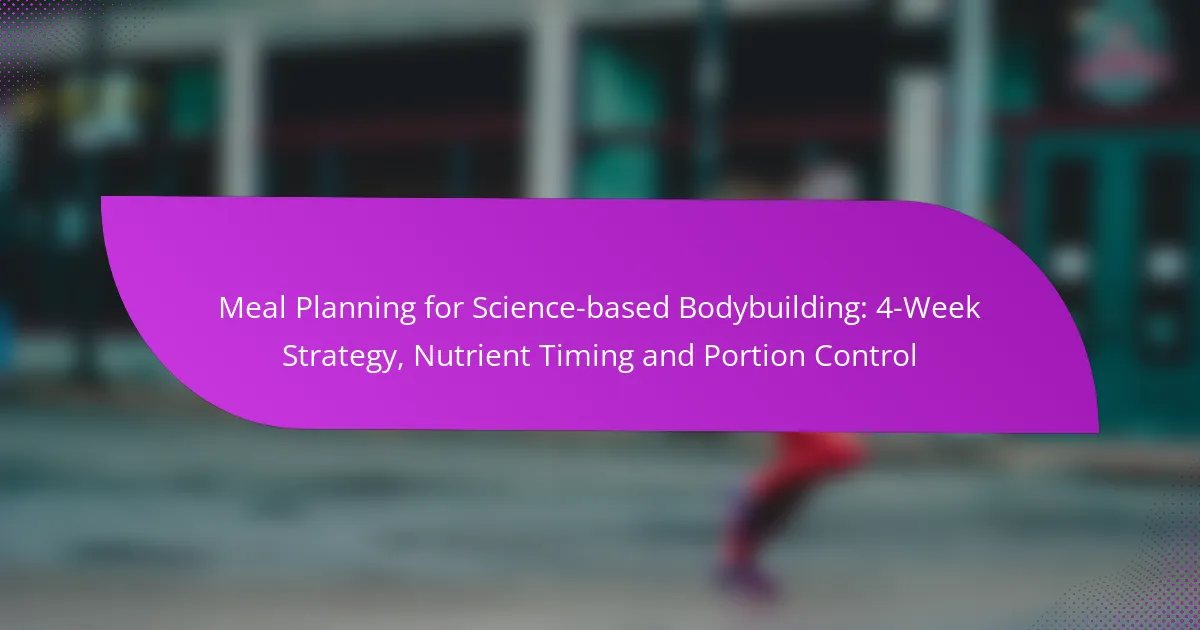Meal planning for bodybuilding is essential for maximizing muscle growth and recovery, and a well-structured 4-week strategy can make a significant difference. By focusing on high-protein, nutrient-dense foods and implementing effective nutrient timing and portion control, you can optimize your performance and achieve your fitness goals. Understanding how to balance your macronutrients and when to consume them will enhance your results and support your bodybuilding journey.

How to Create a 4-Week Meal Plan for Bodybuilding?
Creating a 4-week meal plan for bodybuilding involves strategically selecting foods that support muscle growth and recovery while ensuring proper nutrient timing and portion control. Focus on high-protein, nutrient-dense foods and balance your macronutrients to optimize performance and results.
Step-by-step meal planning process
Begin by determining your daily caloric needs based on your weight, activity level, and bodybuilding goals. Use a reliable online calculator or consult with a nutritionist to establish your baseline. From there, allocate your macronutrients, typically aiming for a ratio of around 40% protein, 40% carbohydrates, and 20% fats.
Next, create a weekly menu that includes a variety of protein sources, whole grains, fruits, and vegetables. Plan meals and snacks to ensure you meet your macronutrient targets throughout the day. Remember to incorporate nutrient timing by consuming protein-rich meals or snacks before and after workouts to support muscle recovery.
Sample 4-week meal plan
A sample 4-week meal plan might include options like grilled chicken with quinoa and broccoli for lunch, and a protein shake with a banana post-workout. For variety, rotate different protein sources such as turkey, fish, and legumes, and include a range of vegetables to ensure adequate micronutrient intake.
Consider using a simple table to outline your meals for each week, ensuring you have a balanced distribution of macronutrients. For example:
| Week | Meal 1 | Meal 2 | Meal 3 |
|---|---|---|---|
| 1 | Oatmeal with protein powder | Grilled chicken salad | Salmon with sweet potatoes |
| 2 | Greek yogurt with berries | Beef stir-fry with brown rice | Tuna with whole grain pasta |
| 3 | Protein pancakes | Turkey wrap with veggies | Eggs with spinach and toast |
| 4 | Chia seed pudding | Chicken fajitas | Quinoa bowl with black beans |
Tools for meal planning
Utilize meal planning apps or spreadsheets to organize your meals and track your macronutrient intake. Popular apps like MyFitnessPal or Cronometer can help you log foods and monitor your progress effectively. These tools often include barcode scanning features for quick entry.
Additionally, consider investing in a food scale to accurately measure portion sizes, ensuring you stay within your caloric and macronutrient goals. This precision can significantly impact your bodybuilding results over time.

What is Nutrient Timing in Bodybuilding?
Nutrient timing in bodybuilding refers to the strategic scheduling of nutrient intake to optimize muscle recovery, growth, and overall performance. This approach emphasizes when to consume specific nutrients, particularly around workouts, to maximize their benefits.
Definition of nutrient timing
Nutrient timing involves planning meals and snacks at specific times to enhance the body’s metabolic response. It typically focuses on the timing of carbohydrates and proteins before, during, and after exercise to support energy levels and muscle repair.
For instance, consuming a protein-rich meal within a couple of hours post-workout can help stimulate muscle protein synthesis. Similarly, having carbohydrates before a workout can provide the necessary energy for optimal performance.
Importance of nutrient timing
The importance of nutrient timing lies in its potential to improve workout results and recovery. By aligning nutrient intake with the body’s physiological demands, bodybuilders can enhance muscle growth and reduce fatigue.
Research suggests that consuming protein and carbohydrates shortly after exercise can significantly boost recovery. A common guideline is to aim for a meal containing protein and carbs within 30 to 60 minutes post-workout for best results.
Additionally, being mindful of nutrient timing can help prevent energy crashes during workouts and support sustained performance. Avoiding long gaps between meals and strategically timing snacks can keep energy levels stable throughout the day.

How to Control Portions for Bodybuilding?
Controlling portions for bodybuilding involves managing the amount of food consumed to meet specific nutritional goals while supporting muscle growth and fat loss. Effective portion control helps ensure that you are getting the right balance of macronutrients without overeating.
Portion control techniques
Several techniques can help you manage portion sizes effectively. One common method is the plate method, where you fill half your plate with vegetables, a quarter with protein, and a quarter with carbohydrates. This visual cue simplifies meal preparation and encourages balanced eating.
Another technique is mindful eating, which involves paying attention to hunger cues and eating slowly to recognize when you are satisfied. Avoid distractions while eating, as this can lead to overeating. Keeping a food diary can also help track portions and identify patterns in your eating habits.
Using measuring tools
Measuring tools can provide accuracy in portion control, ensuring you meet your nutritional targets. Common tools include kitchen scales, measuring cups, and spoons. For example, weighing protein sources like chicken or fish can help you determine appropriate serving sizes, typically ranging from 100 to 200 grams per meal.
Using a food scale can also help you understand serving sizes for grains and legumes, which can vary significantly. For instance, a standard serving of cooked rice is about 150 grams. Incorporating these tools into your meal prep routine can make it easier to stick to your portion control goals.

What Are the Key Nutrients for Bodybuilding?
The key nutrients for bodybuilding include macronutrients and micronutrients that support muscle growth, recovery, and overall health. Understanding the right balance and timing of these nutrients can significantly enhance performance and results.
Macronutrients breakdown
Macronutrients consist of proteins, carbohydrates, and fats, each playing a vital role in bodybuilding. Proteins are essential for muscle repair and growth, with a common recommendation of 1.6 to 2.2 grams per kilogram of body weight daily. Carbohydrates provide the energy needed for intense workouts, typically making up 45-65% of total daily calories.
Fats, while often overlooked, are crucial for hormone production and overall health. Aim for healthy fats, such as those from avocados, nuts, and olive oil, comprising about 20-35% of your daily caloric intake. Balancing these macronutrients according to your specific goals can optimize muscle gain and fat loss.
Micronutrients importance
Micronutrients, including vitamins and minerals, support various bodily functions that are essential for bodybuilding. For example, calcium and vitamin D are vital for bone health, while B vitamins play a role in energy metabolism. A deficiency in these micronutrients can hinder performance and recovery.
To ensure adequate micronutrient intake, focus on a diverse diet rich in fruits, vegetables, whole grains, and lean proteins. Consider using a food diary or app to track your nutrient intake and identify any gaps. Supplementation may be necessary in some cases, but it’s best to consult with a healthcare professional before starting any new regimen.

How to Adjust Meal Plans for Different Goals?
Adjusting meal plans for different bodybuilding goals involves tailoring macronutrient ratios and caloric intake based on whether you aim to gain muscle or lose fat. Understanding the principles of bulking and cutting will help you create effective meal strategies that align with your objectives.
Bulking vs cutting meal plans
Bulking meal plans focus on a caloric surplus, providing more energy to support muscle growth. Typically, these plans emphasize higher protein and carbohydrate intake, with fats making up a smaller proportion of total calories. For instance, a common macronutrient ratio for bulking might be 40% carbs, 30% protein, and 30% fats.
In contrast, cutting meal plans aim for a caloric deficit to promote fat loss while preserving lean muscle mass. These plans often increase protein intake to help maintain muscle, while reducing carbohydrates and fats. A typical macronutrient ratio for cutting could be 30% carbs, 40% protein, and 30% fats.
Adjusting caloric intake
To adjust caloric intake effectively, start by determining your maintenance calories, which is the amount needed to maintain your current weight. From there, add around 250-500 calories for bulking or reduce by 250-500 calories for cutting, depending on your goals. Monitor your progress and adjust as necessary to ensure you’re on track.
It’s crucial to consider individual factors such as age, weight, activity level, and metabolism when adjusting caloric intake. For example, a younger athlete with a high activity level may require more calories than an older individual with a sedentary lifestyle. Regularly reassess your intake based on changes in body composition and performance.

What Are Common Mistakes in Bodybuilding Meal Planning?
Common mistakes in bodybuilding meal planning include failing to achieve nutrient balance and neglecting meal timing. These oversights can hinder muscle growth and recovery, ultimately affecting performance and results.
Overlooking nutrient balance
Nutrient balance is crucial in bodybuilding meal planning. It involves ensuring an appropriate ratio of macronutrients—proteins, carbohydrates, and fats—to support muscle repair and energy levels. A common pitfall is relying too heavily on one macronutrient, which can lead to deficiencies and suboptimal performance.
For example, a diet excessively high in protein without sufficient carbohydrates can impair recovery and energy during workouts. Aim for a balanced intake, such as 30% protein, 50% carbohydrates, and 20% fats, adjusting based on individual needs and training intensity.
Ignoring meal timing
Meal timing plays a significant role in bodybuilding success. Consuming nutrients at strategic times can enhance muscle recovery and growth. Many bodybuilders overlook the importance of pre- and post-workout meals, which should ideally include a mix of protein and carbohydrates.
For optimal results, aim to eat a meal rich in protein and carbs about 1-2 hours before training and another within 30 minutes post-workout. This helps replenish glycogen stores and kickstart muscle repair. Avoid long gaps between meals to maintain energy levels and support muscle synthesis throughout the day.

How to Incorporate Supplements in Meal Plans?
Incorporating supplements into meal plans can enhance muscle growth and recovery when used correctly. Focus on choosing the right supplements that align with your bodybuilding goals and ensure they complement your overall nutrition strategy.
Popular bodybuilding supplements
Some of the most popular bodybuilding supplements include protein powders, creatine, branched-chain amino acids (BCAAs), and beta-alanine. Protein powders, such as whey or casein, are essential for muscle repair and growth, while creatine helps improve strength and performance during high-intensity workouts. BCAAs can aid in reducing muscle soreness and promoting recovery.
Additionally, pre-workout supplements often contain ingredients designed to boost energy and focus, such as caffeine and citrulline malate. It’s crucial to choose high-quality products from reputable brands to ensure safety and efficacy.
Timing and dosage recommendations
For optimal results, timing and dosage of supplements should align with your training schedule. Protein intake is most effective when consumed within 30 minutes post-workout, ideally in the form of a protein shake or a meal. A typical dosage for creatine is around 3-5 grams daily, taken consistently for best results.
When using pre-workout supplements, take them about 30 minutes before your workout to maximize their effects. Always follow the recommended dosages on the product labels and consult with a healthcare professional if unsure about specific needs or interactions.

What Are Advanced Meal Planning Strategies?
Advanced meal planning strategies involve systematic approaches to optimize nutrition for bodybuilding. These strategies focus on nutrient timing, portion control, and meal composition to enhance muscle growth and recovery.
Nutrient Timing
Nutrient timing refers to the strategic scheduling of food intake around workouts to maximize performance and recovery. Consuming protein and carbohydrates before and after training can significantly enhance muscle repair and glycogen replenishment. Aim for a balanced meal or snack containing protein and carbs within 30 minutes post-workout.
For example, a protein shake with a banana or a chicken sandwich can be effective. Adjust your timing based on your workout schedule, ensuring that you have adequate energy before and nutrients after your sessions.
Portion Control
Portion control is essential in advanced meal planning to ensure you meet your caloric and macronutrient goals without overeating. Use measuring tools or visual cues to help maintain appropriate serving sizes. A common guideline is to fill half your plate with vegetables, a quarter with protein, and a quarter with carbohydrates.
For instance, if your daily caloric intake is around 2,500 calories, aim for meals that are roughly 500-700 calories each, adjusting based on your activity level. Regularly assess your progress and adjust portion sizes as needed to stay aligned with your goals.
Meal Composition
Meal composition involves selecting the right balance of macronutrients—proteins, fats, and carbohydrates—to support muscle growth and overall health. A typical bodybuilding meal might consist of lean protein sources, healthy fats, and complex carbohydrates. For example, grilled salmon with quinoa and steamed broccoli provides a balanced nutrient profile.
Consider incorporating a variety of foods to ensure a wide range of vitamins and minerals. Aim for meals that are approximately 40% carbohydrates, 30% protein, and 30% fats, adjusting these ratios based on your specific needs and preferences.



